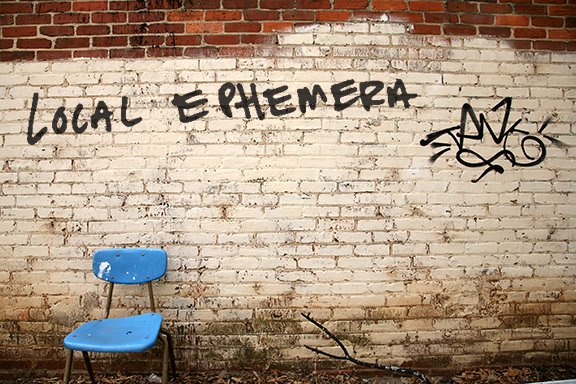 "C.S.H. #2 Sumner Spaulding & John Rex (North & South Elevations)"
"C.S.H. #2 Sumner Spaulding & John Rex (North & South Elevations)"
The body of work is the result of Ingram's study (and love) of Modern Architecture. The works are part of an ongoing series of paintings based on the elevations of buildings representing aspects of the architectural movement. The massive diptych above, 13' in width, is the north and south elevations of a building by Spaulding and Rex.
Interestingly, when viewing the show I felt I had entered into a show of sculpture, but Ingram instead referred to this piece as a painting, defining it this way largely because of the treatment of surface. Ingram said each color was given a different and specific surface texture that was uniform for each color. The idea that surface texture can define a work as a painting instead of a sculpture is something to chew on. After all, these paintings derive their shapes from the elevations of three-dimensional buildings. Frank Stella "Harran II" 1967
Frank Stella "Harran II" 1967
It makes me think of Frank Stella's paintings and his push to make the painting itself the art object. Stella would attempt this with the shape of his canvas becoming as, or more, important than the painting on the actual canvas surface. One difference is that Stella's forms derived from a protractor and pencil on paper. The design thus stayed largely two-dimensional. The shape of Ingram's paintings are instead deriving from a three-dimensional building and remain fairly three dimensional, with varying levels of depth in the finished paintings. Maybe it's because the shape of Stella's canvases are abstract whereas Ingram's insinuate buildings that I have a harder time comprehending the latter as paintings.

Ingram said his purpose in this body of work was to reexamine elements of Modern Architecture and attempt to "warm up" a minimal architectural style historically considered cold, stark and industrial. An example being his recreation of cinder blocks, a basic architectural component, in the "warmer" organic material wood. There was also a wooden I-beam placed in the entrance way. Ingram's wood working abilities and impeccable craft are readily apparent in this show.

A couple of photographs by the famous architectural photographer Julius Shulman were borrowed from Jackson Fine Art. Ingram said he wanted to include these to "set the stage" or further build the context for his works. The photographs were interesting for the surrealist quality they have attained over time. Without labels on the walls, at first I assumed the works were collages of magazine cut-outs by Ingram, referencing the time period of this architecture. The photographs almost seem like a parody of themselves now, the people and furniture so steeped in a style that has become stereotypical of the time period.


As a sort of study, Ingram made a work on paper reducing the elevation of the Eames House and Studio into simplified blocks of color. The decision to include the rectangles of primary colors into the scheme is a distraction for me. The colors make the pieces too accessible, too immediately gratifying, something like a decorative Mondrian, which is, probably, what this piece is a study of - how the Eames house used color to become accessible. Some of the paintings, and especially this one, seem to waver between meditation on form/material/color and love for the slick aesthetic of modernist design.
 The very opposite is true for the 3-D "drawing" of the Eames house. The wood represents the concrete retaining wall behind the house and the lines of the building are slats of metal inlayed in wood. By removing the distraction of popping colors these subdued shapes get at the bold simplicity of Modernism while using raw wood to imbibe it with warmth. It's sexy I tell you.
The very opposite is true for the 3-D "drawing" of the Eames house. The wood represents the concrete retaining wall behind the house and the lines of the building are slats of metal inlayed in wood. By removing the distraction of popping colors these subdued shapes get at the bold simplicity of Modernism while using raw wood to imbibe it with warmth. It's sexy I tell you.For me the show was less interesting in its discussion of Modern Architecture than in Ingram's opinions of what constitutes a drawing or painting versus a sculpture. Ingram considers the above piece to be a "drawing" (which means it IS a drawing right? Because artists, I guess, do actually get to decide things like what medium their work is considered.) Ingram's reasoning for this was that drawing is "simple mark making" regardless of material and he marked the wood with lines of aluminum.

Here is the study for the piece that became the highlight of the show for me.
 "Dekalb Ave. Fire Station (West Elevation)"
"Dekalb Ave. Fire Station (West Elevation)"Ingram collaborated with North Carolina photographer Pam Pecchio, using one of her photographs as the backdrop for his painting. I am a big fan of Pecchio's work, having seen it at the ACP portfolio review in October (see previous post). The combination of works is really interesting as it shows the contrast of the modern form with the landscape, highlighting what is so jarring about modernism. Ingram mentioned that while Pecchio liked the finished piece, she did not see this as the preferred direction for her work, which makes sense because the photograph is only adding another dimension to the real focal point, the painting.

1 comment:
http://hue.vietnamnet.vn/dataimages/original/images218609_tranhPeterDoig.jpg
Post a Comment